Succulents plants: Stapelia gigantea - Asclepiadaceae
Stapelia gigantea flowers
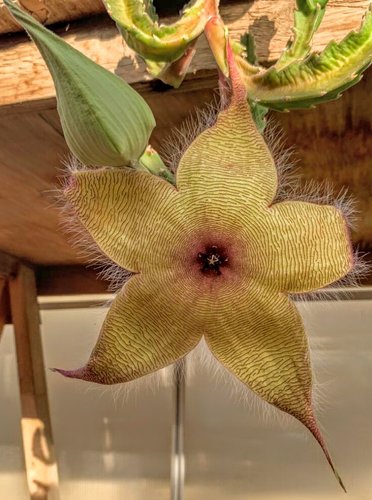
Appartenente alla famiglia delle Asclepiadaceae, la Stapelia gigantea è originaria dell' Africa "tropicale", luoghi come South Africa e Tanzania ma anche Malawi, Mozambico, Botswana e Zimbabwe.
La pianta si presenta con fusti dentellati e piuttosto carnosi che non vanno oltre i 20/25 cm. Il portamento è prostrato lungo il terreno che si presenta piuttosto secco, molto drenante ed in parte sabbioso.
Le foglie sono molto piccole, ridotte a pochi millimetri lungo i tubercoli.
Molto importante è il sole che a seconda della forte esposizione porterà i fusti ad avere un colore rossiccio, talvolta anche violaceo (se cosi fosse è bene non continuarla ad esporla al sole diretto).
Durante lo sviluppo è bene tenere i fusti sempre ben turgidi con irrigazioni abbondanti facendo attenzione a far asciugare il substrato tra un innaffiatura e l'altra. Per l'estate è meglio non eccedere ma lasciarla leggermente leggermente disidratata per evitare "cotture" indesiderate con le alte temperature.
Con l'arrivo dell'inverno invece è bene sospendere le irrigazioni già da settembre inizio ottobre portandola ad un buona disidratazione. Nonostante non tolleri temperature basse (minime di 10/7 gradi) è possibile con le giuste accortezze anche farla "svernare" in serra fredda evitando ovviamente le gelate persistenti.
Belonging to the Asclepiadaceae family, the Stapelia gigantea is native to "tropical" Africa, places like South Africa and Tanzania but also Malawi, Mozambique, Botswana and Zimbabwe.
The plant has jagged and rather fleshy stems that do not exceed 20/25 cm. The habit is prostrate along the ground which is rather dry, very draining and partly sandy.
The leaves are very small, reduced to a few millimeters along the tubercles.
Very important is the sun that depending on the strong exposure will lead the stems to have a reddish color, sometimes even purple (if so it is good not to continue to expose it to the direct sun).
During development it is advisable to keep the stems always well turgid with abundant irrigations, being careful to let the substratum dry out between one watering and another. For the summer it is best not to exceed but leave it slightly slightly dehydrated to avoid unwanted "cooking" with high temperatures.
With the arrival of winter, instead, it is good to suspend the irrigations already from September to the beginning of October, leading to a good dehydration. Despite not tolerating low temperatures (minimum 10/7 degrees) it is possible with the right precautions to also make it "winter" in a cold greenhouse, obviously avoiding persistent frosts.
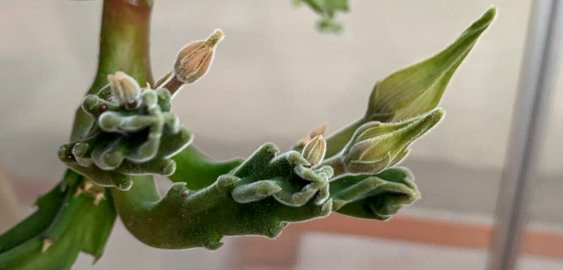
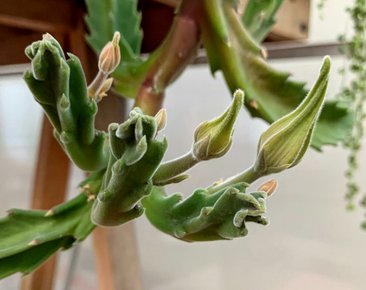
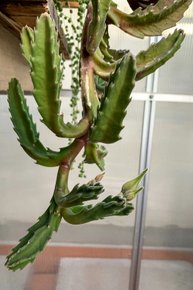
La vera particolarità come avete notato è il grande fiore di questa pianta dal quale prende il nome della specie, gigantea. Generalmente dura molto poco, al massimo 2/3 giorni nelle giornate fresche.
Le dimensioni sono veramente notevoli, da punta a punta misura anche 30/40 cm.
The real peculiarity as you have noticed is the large flower of this plant from which it takes the name of the species, gigantea. Generally it lasts very little, at most 2/3 days on cool days.
The dimensions are really remarkable, from tip to tip it also measures 30/40 cm.
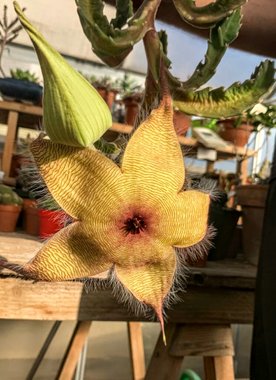
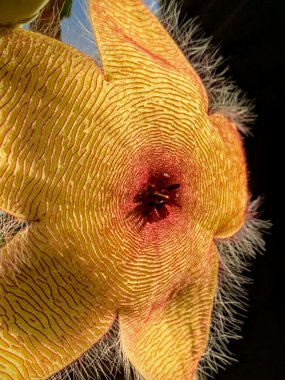
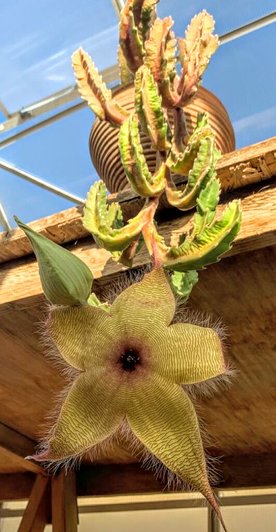
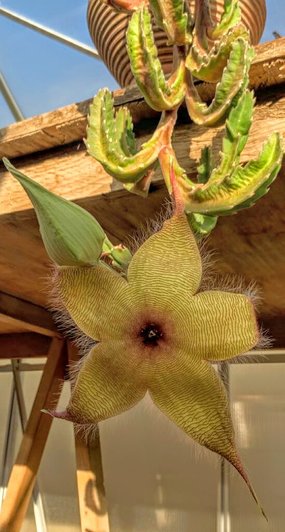
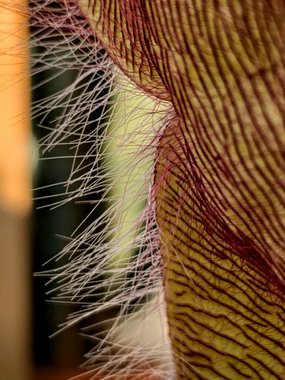
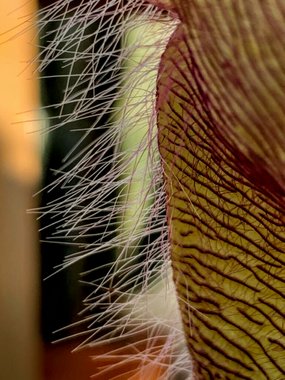
I lobi, che formano la corolla del fiore, dopo l'apertura si protraggono all'indietro mettendo in vista la corona centrale della pianta contenente gli organi riproduttivi. Solo in un secondo momento si richiudono in avanti "intrappolando" le larve e mosche che sono all'interno. I suoi insetti impollinatori sono infatti mosconi ed altri ditteri attirati dal forte odore putrido di carne marcia che emana durante tutto il giorno, a svanire fino a sera ( Confermo che la serra era veramente impraticabile). Oltre l'odore, anche i colori del fiore attirano questi insetti, le strisce rossicce ed il colore giallognolo, risultano come una carcassa o carne marcia agli occhi degli insetti pronubi.
The lobes, which form the corolla of the flower, after opening extend backwards, exposing the central crown of the plant containing the reproductive organs. Only later will they close forward by "trapping" the larvae and flies that are inside. Its pollinating insects are in fact flies and other Diptera attracted by the strong putrid smell of rotten meat that emanates throughout the day, to fade until evening (I confirm that the greenhouse was really impractical). Besides the smell, even the colors of the flower attract these insects, the reddish stripes and the yellowish color, result as a carcass or rotten meat to the eyes of the pollinating insects.
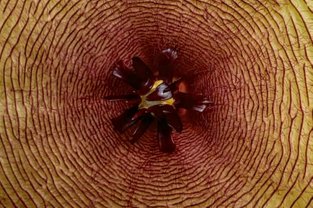
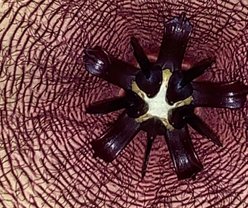
Spero più avanti di potervi mostrare gli organi riproduttivi e l'effettiva impollinazione, magari sotto l'osservazione di un microscopio biologico. Vi saluto con la pianta completa.
I hope later to be able to show you the reproductive organs and the actual pollination, perhaps under the observation of a biological microscope. I greet you with the complete plant.

Tutte le foto sono di mia proprietà
All photos are my property
That's gorgeous! Bet the smell is very memorable too :)
I have a dark red one. Such a cool plant!
hahaha right, you couldn't breathe in the greenhouse! I believe you have a Stapelia grandiflora! Very beautiful!
Yea.. I that's the name :)
Wooo =)) Cool!! 🌵🌵🌵🌵🌵
Thanks! It is :D
A very strange plant!!
stranger things
I never saw that plant before! Nice pics!!
Thanks @serlanvet! =)
@tipu curate
@giphy curate 100
A huge hug from @amico! 🤗
#sbi-skip !trdo
Upvoted 👌
Powered by witness untersatz!
Upvoted 👌 (Mana: 0/15 - need recharge?)
Grazie amico! ;)
This post was selected, voted and shared by the discovery-it curation team in collaboration with the C-Squared Curation Collective. You can use the #Discovery-it tag to make your posts easy to find in the eyes of the curator. We also encourage you to vote @c-squared as a witness to support this project.
Thanks!
Hello,
Your post has been manually curated by a @stem.curate curator.
We are dedicated to supporting great content, like yours on the STEMGeeks tribe.
Please join us on discord.
Thanks for the support!
Congratulations @cooltivar, your post successfully recieved 0.30341588 TRDO from below listed TRENDO callers:
To view or trade TRDO go to steem-engine.com
Join TRDO Discord Channel or Join TRDO Web Site